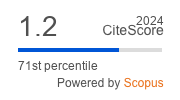Cognitive Exploration of ‘Traveling’ in the Poetry of Widad Benmoussa
DOI:
https://doi.org/10.29038/eejpl.2018.5.2.areKeywords:
physical path, inner path, traveling, conceptual metaphor, relativity, metaNet.Abstract
The concept of motion is central to the human cognition and it is universally studied in cognitive linguistics. This research paper investigates concept of motion, with special reference to traveling, in the poetry of Widad Benmoussa. It mainly focuses on the cognitive dimensions underlying the metaphorical representation of traveling. To this end, the research conducts a semi-automated analysis of a corpus representing Widad’s poetic collections. MetaNet’s physical path is mainly used to reveal the cognitive respects of traveling. The personae the poetess assigns are found to pursue a dynamic goal through activation of several physical paths. During the unstable romantic relations, several travel impediments are met. Travel stops and detours, travel companions, paths in journey as well as changing travel destinations are the most stressed elements of ‘Traveling’ respects. With such a described high frequency of sudden departures and hopping, the male persona the poetess assigns evinces typical features of 'wanderlust' or dromomania.
References
- Arenas, E. S. (2018). Exploring pornography in Widad Benmoussa’s poetry using LIWC and corpus tools. Sexuality & Culture, 22(4), 1094–1111.
- Baicchi, A. (2017). The relevance of conceptual metaphor in semantic interpretation. Estetica. Studi e Ricerche, 7(1), 155–170.
- Carey, A. L., Brucks, M. S., Küfner, A. C., Holtzman, N. S., Back, M. D., Donnellan, M. B., ... & Mehl, M. R. (2015). Narcissism and the use of personal pronouns revisited. Journal of Personality and Social Psychology, 109(3), e1.
- David, O., & Matlock, T. (2018). Cross-linguistic automated detection of metaphors for poverty and cancer. Language and Cognition, 10(3), 467–493.
- David, O., Lakoff, G., & Stickles, E. (2016). Cascades in metaphor and grammar. Constructions and Frames, 8(2), 214–255.
- Essam, B. A. (2016). Nizarre Qabbani’s original versus translated pornographic ideology: A corpus-based study. Sexuality & Culture, 20(4), 965–986
- Forceville, C. (2016). Conceptual metaphor theory, blending theory, and other cognitivist perspectives on comics. The Visual Narrative Reader, 89–114.
- Gibbs Jr, R. W. (2011). Evaluating conceptual metaphor theory. Discourse Processes, 48(8), 529–562.
- Kövecses, Z. (2008). Conceptual metaphor theory: Some criticisms and alternative proposals. Annual Review of Cognitive Linguistics, 6(1), 168–184.
- Lakoff, G. (2014). Mapping the brain's metaphor circuitry: Metaphorical thought in everyday reason. Frontiers in Human Neuroscience, 8, 958.
- Lakoff, G., & Johnson, M. (2008). Metaphors We Live By. University of Chicago press.
- Lee, M. G., & Barnden, J. A. (2001). Mental metaphors from the Master Metaphor List: Empirical examples and the application of the ATT-Meta system. Cognitive Science Research Papers-University of Birmingham CSRP.
- Lönneker-Rodman, B. (2008). The Hamburg metaphor database project: issues in resource creation. Language Resources and Evaluation, 42(3), 293–318.
- Martin, J. H. (1994). Metabank: A knowledge‐base of metaphoric language conventioms. Computational Intelligence, 10(2), 134–149.
- MetaNet Web Site: https://metanet.icsi.berkeley.edu/metanet/
- Pennebaker, J. W., Boyd, R. L., Jordan, K., & Blackburn, K. (2015). The development and psychometric properties of LIWC2015. Retrieved from https://repositories.lib.utexas.edu/ handle/2152/31333
- Santarpia, A., Blanchet, A., Venturini, R., Cavallo, M., & Raynaud, S. (2006, August). La catégorisation des métaphores conceptuelles du corps. In Annales Médico-psychologiques, revue psychiatrique. Vol. 164, No. 6. (pp. 476-485). Elsevier Masson.
- Stickles, E., David, O., Dodge, E. K., & Hong, J. (2016). Formalizing contemporary conceptual metaphor theory. Constructions and Frames, 8(2), 166–213
- Tausczik, Y. R., & Pennebaker, J. W. (2010). The psychological meaning of words: LIWC and computerized text analysis methods. Journal of Language and Social Psychology,29(1), 24–54.
Sources
- Benmoussa, W. (2001). I have Roots in Air (in Arabic). Morocco: Ministry of Culture.
- Benmoussa, W. (2006). Between Two Clouds (in Arabic and French). Morocco: Marsam Publishing House.
- Benmoussa, W. (2007). I Opened It on You (in Arabic). Morocco: Marsam Publishing House.
- Benmoussa, W. (2008). Storm in a Body (in Arabic). Morocco: Marsam Publishing House.
- Benmoussa, W. (2010). I Hardly Lost my Narcissism (in Arabic). Syria: Ward Publishing House.
- Benmoussa, W. (2014). I Stroll Along This Life. Morocco: Tobkal Publishing House












 Creative Commons «Attribution» 4.0
Creative Commons «Attribution» 4.0